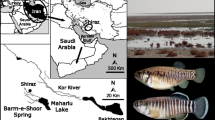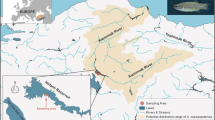Abstract
We report the first data on the use of occasionally inundated habitats in a Mediterranean coastal lagoon by the Spanish toothcarp (Aphanius iberus), a cyprinodontid fish in danger of extinction. During a flooding period, we sampled the fish population and the macroinvertebrate community in three contrasting habitats: mats of green algae, open water, and a habitat dominated by glasswort (Salicornia patula) that is occasionally inundated. The three habitats displayed strong variation in density and species composition of invertebrates in the water column and the benthos. In general, algal mats had higher invertebrate biomasses, but glasswort had higher diversity of organisms, in part of terrestrial origin. The density of toothcarp was very low in the open water. The habitat that is occasionally inundated (glasswort) significantly had the highest density of mature toothcarp, while immature fish were similarly abundant in the glasswort and algal mat habitats. Condition (weight–length relationship) and total food biomass in the gut contents of immature toothcarp was significantly higher in algal mats than in glasswort, whereas there were no such differences for mature fish. Therefore, the occasionally flooded habitat (glasswort) was positively selected by large mature toothcarp but seemed a disadvantageous habitat for immature individuals.






Similar content being viewed by others
References
Alcaraz, C. & E. García-Berthou, 2007. Food of an endangered cyprinodont (Aphanius iberus): ontogenetic diet shift and prey electivity. Environmental Biology of Fishes, 78: 193–207.
Badosa, A., D. Boix, S. Brucet, R. López-Flores, S. Gascón & X. D. Quintana, 2007. Zooplankton taxonomic and size diversity in Mediterranean coastal lagoons (NE Iberian Peninsula): influence of hydrology, nutrient composition, food resource availability and predation. Estuarine, Coastal and Shelf Science 71: 335–346.
Bonnet, E. & Y. Van de Peer, 2002. Zt: a software tool for simple and partial Mantel tests. Journal of Statistical Software 7: 1–12.
Day, R. W. & G. P. Quinn, 1989. Comparisons of treatments after an analysis of variance in ecology. Ecological Monographs 59: 433–463.
De Szalay, F. A. & V. H. Resh, 2000. Factors influencing macroinvertebrate colonization of seasonal wetlands: responses to emergent plant cover. Freshwater Biology 45: 295–308.
Doadrio, I. (ed.), 2001. Atlas y libro rojo de los peces continentales de España. Ministerio de Medio Ambiente, Madrid.
Dumont, H. J., I. Van de Velde & S. Dumont, 1975. The dry weight estimate of biomass in a selection of Cladocera, Copepoda and Rotifera from the plankton, periphyton and benthos of continental waters. Oecologia 19: 75–97.
Fortin, M. & J. Gurevitch, 2001. Mantel tests: spatial structure in field experiments. In Scheiner, S. M. & J. Gurevitch (eds), Design and Analysis of Ecological Experiments. Oxford University Press, New York, 308–326.
García-Berthou, E. & R. Moreno-Amich, 1992. Age and growth of an Iberian cyprinodont, Aphanius iberus (Cuv. & Val.), in its most northerly population. Journal of Fish Biology 40: 929–937.
García-Berthou, E. & R. Moreno-Amich, 1993. Multivariate analysis of covariance in morphometric studies of the reproductive cycle. Canadian Journal of Fisheries and Aquatic Sciences 50: 1394–1399.
Gesti, J., A. Badosa & X. D. Quintana, 2005. Reproductive potential in Ruppia cirrhosa (Petagna) Grande in response to water permanence. Aquatic Botany 81: 191–198.
Hindell, J. S., G. P. Jenkins & M. J. Keough, 2001. Spatial and temporal variability in the effects of fish predation on macrofauna in relation to habitat complexity and cage effects. Marine Ecology Progress Series 224: 231–250.
Jordan, F., 2002. Field and laboratory evaluation of habitat use by rainwater killifish (Lucania parva) in the St. Johns River Estuary, Florida. Estuaries 25: 288–295.
Jordan, C. F., S. Coyne & J. C. Trexler, 1997. Sampling fishes in heavily vegetated habitats: the effects of habitat structure on sampling characteristics of the 1-m2 throw trap. Transactions of the American Fisheries Society 126: 1012–1020.
Kneib, R. T. & S. L. Wagner, 1994. Nekton use of vegetated marsh habitats at different stages of tidal inundation. Marine Ecology Progress Series 106: 227–238.
Lewin, W. C., N. Okun & T. Mehner, 2004. Determinants of the distribution of juvenile fish in the littoral area of a shallow lake. Freshwater Biology 49: 410–424.
Lotrich, V. A., 1975. Summer home range and movements of Fundulus heteroclitus (Pisces: Cyprinodontidae) in a tidal creek. Ecology 56: 191–198.
Marklund, O., I. Blindow & A. Hargeby, 2001. Distribution and diel migration of macroinvertebrates within dense submerged vegetation. Freshwater Biology 46: 913–924.
Meredith, W. H. & V. A. Lotrich, 1979. Production dynamics of a tidal creek population of Fundulus heteroclitus (Linnaeus). Estuarine, Coastal and Shelf Science 8: 99–118.
Planelles-Gomis, M. (ed.), 1999. Peces ciprinodóntidos ibéricos. Fartet y Samaruc. Generalitat Valenciana, València.
Raffaelli, D., J. A. Raven & L. J. Poole, 1998. Ecological impact of green macroalgal blooms. Oceanography and Marine Biology 36: 97–125.
Rincón, P. A., A. M. Correas, F. Morcillo, P. Risueño & J. Lobón-Cerviá, 2002. Interaction between the introduced eastern mosquitofish and two autochthonous Spanish toothcarps. Journal of Fish Biology 61: 1560–1585.
Smock, L. A., 1980. Relationships between body size and biomass of aquatic insects. Freshwater Biology 10: 375–383.
Tabachnick, B. G. & L. S. Fidell, 2001. Computer-assisted research design and analysis. Allyn and Bacon, Boston, 748 pp.
Talley, T. S. & L. A. Levin, 1999. Macrofaunal succession and community structure in Salicornia marshes of southern California. Estuarine Coastal and Shelf Science 49: 713–731.
Vargas, M. J. & A. de Sosota, 1999. Ecología trófica del fartet, Lebias ibera, en el Delta del Ebro. In Planelles-Gomis, M. (ed.), Peces ciprinodóntidos ibéricos. Fartet y Samaruc. Generalitat Valenciana, València, 133–161.
Weisberg, S. B. & V. A. Lotrich, 1982. The importance of an infrequently flooded intertidal marsh surface as an energy source for the mummichog Fundulus heteroclitus: an experimental approach. Marine Biology 66:307–310.
Acknowledgements
We thank L.M. Bini, M. Fox, R.T. Kneib, and two anonymous referees for helpful comments that substantially improved an earlier draft of this manuscript. Financial support was provided by the Spanish Ministry of Science and Technology (REN2003-00477), the Government of Catalonia (Catalan Government Distinction Award for university research 2004 to EGB) and a LIFE-Nature project (LIFE 99 NAT/E/00 6386). CA held a doctoral fellowship (FPU AP 2002-0206) from the Spanish Ministry of Education.
Author information
Authors and Affiliations
Corresponding author
Additional information
Handling editor: L. Mauricio Bini.
Rights and permissions
About this article
Cite this article
Alcaraz, C., Pou-Rovira, Q. & García-Berthou, E. Use of a flooded salt marsh habitat by an endangered cyprinodontid fish (Aphanius iberus). Hydrobiologia 600, 177–185 (2008). https://doi.org/10.1007/s10750-007-9230-y
Received:
Revised:
Accepted:
Published:
Issue Date:
DOI: https://doi.org/10.1007/s10750-007-9230-y




